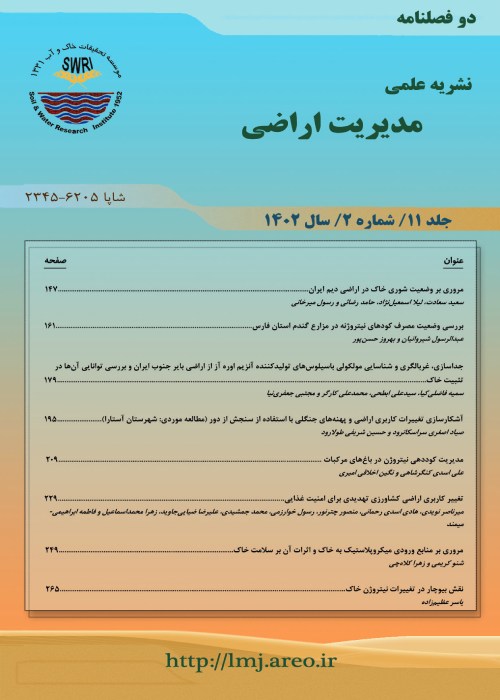Effects of spatial and temporal variations in airborne dust sources on supercritical visibility events in Ahvaz
Author(s):
Article Type:
Research/Original Article (دارای رتبه معتبر)
Abstract:
Supercritical visibility, defined as a 100-meter horizontal field of view (HFOV), is taking an incremental trend in Khuzestan Province due to the increasing development of drought-stricken eroded land as the source of airborne dust, continued drought, and the rising trend in climate change. Surveying the internal land sources of airborne dust, the present study explores the effects of wind direction and speed on this phenomenon in the metropolitan city of Ahvaz. For this purpose, 100-meter HFOVs are initially zoned for a 15-year statistical period to identify the more critical locations in terms of HFOV frequency. Moreover, the long-term annual changes and monthly distributions of the event measured at Ahvaz synoptic station are plotted for the 65-year statistical period of 1952‒2017. Given the significance of steady and calm weather for 100-meter HFOV events, the monthly and hourly events recorded at the station in Ahvaz under steady calm atmosphere are studied. The WR-PLOT software is then used not only to plot the general long-term annual dust rose but also to derive the seasonal distributions of wind direction and speed associated with the events in order to plot and analyze the dust rose for each season. It is found that the annual number of 100-meter HFOV events and its monthly distributions indicate a higher frequency in cold seasons such that the highest number of events belongs to January, December, and February while the lowest belongs to June and July. It is also observed that most dust storms in the warm season have western and northwestern origins while those in the cold season originate from the east and southeast. Due to the heavy air weight and inversion in cold seasons, the 100-meter HFOVs occur mostly at 6 am local time. No significant direct or inverse correlations are observed between 100-meter HFOVs and wind speed due to the dual role of wind in the removal and deposition of dust particles. Overall, 83% of the events are observed to occur during the hours before the noontime and 61.8% of the events occur in very stable weather conditions and calm atmosphere, which allow for the subsidence and deposition of dust particles. Knowledge of the temporal and spatial distributions of supercritical 100-meter HFOVs can be useful for planning operations by the air monitoring and dust control center, flight schedules, and suspension of schools and public offices during critical dust storms.
Keywords:
Language:
Persian
Published:
Journal of Land Management, Volume:7 Issue: 2, 2019
Pages:
195 to 209
magiran.com/p2059046
دانلود و مطالعه متن این مقاله با یکی از روشهای زیر امکان پذیر است:
اشتراک شخصی
با عضویت و پرداخت آنلاین حق اشتراک یکساله به مبلغ 1,390,000ريال میتوانید 70 عنوان مطلب دانلود کنید!
اشتراک سازمانی
به کتابخانه دانشگاه یا محل کار خود پیشنهاد کنید تا اشتراک سازمانی این پایگاه را برای دسترسی نامحدود همه کاربران به متن مطالب تهیه نمایند!
توجه!
- حق عضویت دریافتی صرف حمایت از نشریات عضو و نگهداری، تکمیل و توسعه مگیران میشود.
- پرداخت حق اشتراک و دانلود مقالات اجازه بازنشر آن در سایر رسانههای چاپی و دیجیتال را به کاربر نمیدهد.
In order to view content subscription is required
Personal subscription
Subscribe magiran.com for 70 € euros via PayPal and download 70 articles during a year.
Organization subscription
Please contact us to subscribe your university or library for unlimited access!


